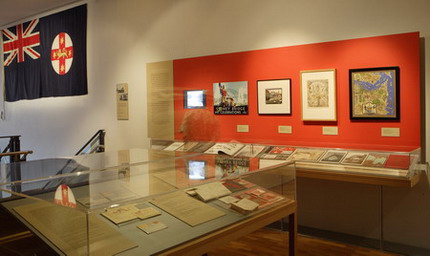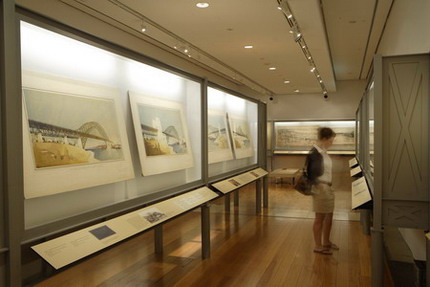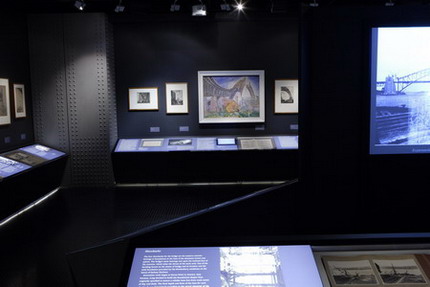
My favourite in this 'little bridge' genre, though not displayed here for understandable reasons, is the one executed in wrought iron which is welded proudly atop the gateway to a house on Epping Road in Lane Cove West. But these days, six lanes of traffic roar incessantly outside this house, while the recently opened, expensive and ill-starred tunnel nearby will surely suffer the fate of all major traffic arteries, including 'our bridge': it will fill up and choke with cars in peak hour. This little bridge and all the other little ones in the exhibition, celebrate the 'big bridge' a few kilometres further down the highway. Yet the Sydney Harbour Bridge also helped create the dire and seemingly insurmountable traffic problems Sydney now faces. It got the ball rolling.
The great champion and engineer of the Sydney Harbour Bridge, John Job Crew Bradfield, is not usually portrayed as a thoughtful, reflective or philosophical man — we tend to see him as an obsessed visionary, totally practical, energetic to the point of hyperactivity. Yet, in the aftermath of the First World War, he wrote this of the relationship between public works, people, environments, cities and the nation:Due to our gallant soldiers, Australia has recently been acclaimed a nation. In the upbuilding of any nation the land slowly moulds the people, the people with patient toil alter the face of the landscape; clearing forests, draining swamps, tilling fields, constructing roads and railways, building factories and rearing cities, they humanise the landscape after their own image. This in the years to come will result in the perfected product, land and people, body and soul, bound together by innumerable and subtle ties. Future generations will judge our generation by our works. For that reason and from consideration of the past, I have recommended granite, strong, imperishable, a natural product, rather than a cheaper artificial material although the cost is £240,000 greater; humanising our landscape in simplicity, strength and sincerity.[1]
Bradfield saw the bridge as very much part of Australia's inevitable historical progress as a nation. He was a thorough modern, but his historical ideas were firmly rooted in eighteenth-century ideas of the course of Empire. He writes of landscapes and people interacting and moulding one another and, extraordinarily, he is not talking about the bush, but about the cities. And, imagine a tender for a major piece of infrastructure these days that insisted on a much more expensive material in order to 'humanise our landscape in simplicity, strength and sincerity'! This exhibition, and this anniversary, offer an opportunity to celebrate this mighty, famous and well-loved structure; but also to think about the issues Bradfield raised. How are Australian city-dwellers shaped by their environments? For better or worse? Can we still say we are 'humanising the landscape'? Do we still think our cities are perfectable? Do we still have faith in the sort of modern planning Bradfield preached and practised? Do we really have 'consideration of the past'? How do we judge Bradfield and his bridge? And what would Bradfield have thought of the endless columns of headlights moving snail-paced down Epping Road at 6.30 every night of the working week?
This 75th anniversary exhibition must have presented the curator with an embarrassment of riches. The bridge was famous before it was begun. Unlike so many other major social and urban developments, the planners, builders and politicians were keenly aware that they were 'making history'. So thousands of plans and photographs were made and carefully archived, debates and reports were published, every milestone was celebrated and recorded, and people kept train tickets and invitations and ribbons and tokens. It is an extraordinary achievement to locate and select from this vast archive, and to bring such a disparate collection together coherently.
Bridging Sydney is therefore larger than the usual temporary exhibitions at the Museum of Sydney — it occupies two galleries and a large area of the landing outside them. The two galleries might be said to cover 'planning' and 'construction' respectively, while the landing areas present the more 'social' aspects of the bridge's history: the little bridges (ashtrays, toys and so on) and then the material on the opening celebrations and glass cases full of bridge memorabilia (special coins, rosettes, tickets). There are pictures of the early toll collectors, separated from cars only by a slender metal railing. This is a nice chance for a bit of nostalgia — elderly ladies pore happily over the glass cases on the landing. 'I think I've got some of those stamps', says one; 'I remember those toll collectors', says her friend. It's like seeing old friends.
The first gallery tells the long, tortuous story of how the New South Wales Government decided to build the bridge. It begins, of course, in 1788 when, in a stroke of eerie historical coincidence, the poet Erasmus Darwin mentioned a 'proud arch' in his visionary poem on Sydney's bright future. Moving right along to a truss bridge dreamed up by one Peter Henderson in 1857, and some nice Joseph Lycett pictures of the North Shore. ('Look at that,' says an elderly man next to me, lost in wonder. 'The North Shore. All bush!') We soon arrive in the 1880s, when the residents of the North Shore were already petitioning parliament for a bridge. By the 1890s and 1900s the first competitions were held, and a string of royal commissions which all concluded a bridge or a tunnel would be necessary. But nothing seemed to happen, until Bradfield, the principal designing engineer for Public Works Department, strode onto the historical stage and took the helm. Bradfield was allowed to work exclusively on the drawings, and he set forth, in the great Australian tradition, on Overseas Fact-Finding Missions. His beautifully written reports are on display. Slowly we see the shift from tram-tunnel to tunnel to cantilever bridge, and finally an arch bridge very much like the decidedly non-famous and uncelebrated Kill Van Kull bridge in New York (of the latter there is no mention yet, however).
What is a little frustrating is that the exhibition raises a lot of questions which it doesn't answer — even the most basic. Why was the tunnel idea abandoned in favour of a bridge? Why did Bradfield suddenly change his mind and choose the arch over the bridge he'd already drawn up? And the words I quoted above, perhaps the key to his big-picture thinking, are lost in the fine print on page 62 of the 1924 Sydney Harbour Bridge Report on Tenders. Elsewhere the exhibition simply tells us he chose granite for the pylons because it was 'dignified'.
Every plan and report is here, though, carefully labelled, beautifully displayed, easy to see. There are also several drawings of imagined and rather bizarre bridges which never left the drawing board and allow delicious games of 'what if?' My favourite was a three-way bridge with Goat Island at the centre and renamed Anzac Isle — it was to be 'a miniature replica of Anzac Bay and coastline'. As we move inexorably towards construction, the drawings take more recognisable shape: finally there are tender watercolours produced by the artist working for contractors Dorman Long and Co. They show a transformed landscape, not only the bridge, but a new waterfront lined with the Italianate mansions and gardens dreamed up by Bradfield, set in a seductive, modernistic ensemble of steel arch, sleek ocean liners, motor launches — and not a horse in sight!
On the other side of this panel is the other side of the bridge's construction, the other side of modernist visions: the extensive demolition of old housing stock, and the dislocation of hundreds of working families in the Rocks and at Milsons Point. Bradfield himself acknowledged this 'flip side', though the section begins with his 1926 platitude that 'Every government public work is attended with loss and inconvenience to somebody'. So true, though it might have been pointed out that the 'somebodies' are never the great and the good, the well-heeled and influential. After all, for whom were those new harbourside Italianate flats intended? And it is strange that the exhibition doesn't mention the fact that the waterfront area on the south had already been resumed in 1900 after an outbreak of bubonic plague. This was very convenient for the bridge-planners, to say the least. The exhibition includes Bradfield's remark that evicting the people and demolishing their homes involved 'many touches of pathos [this was] the most trying phase of the construction of the bridge'. What, more trying than getting those arches to meet? This is worth investigating! But this part of the display does not go there; it is a bit rushed and tokenistic. There are albums of pictures of houses coming down, but nothing on what it must have been like for poor families of the Rocks and Milsons Point to have to shift and find new homes.
This relentless retelling of the 'official' version in all its historical inevitability is still clearer in the second gallery, which explores the construction phase. There is little or nothing on alternative voices, wider impacts and outcomes, for the story is one of technical achievement, overcoming odds, celebration, joy and affection. Which is all true, but not the only truth. Again, the displays are technically excellent and accessible: visitors do not need to stoop and squint; visitors in wheelchairs are also easily able to pore over the captions and pictures. Some of the enormously long plans must have been a challenge to get right — and they look great. A particularly nice device was the pairing of technical data on construction with the beautiful art works of Percy Lindsay and Jessie Trail, and Grace Cossington Smith's awesome The Curve of the Bridge. Then the bridge is anatomised in an avalanche of technical detail, from the great bearings to the creeper cranes, the skewbacks, and down to the granite quarrying that grew a town at Moruya. The virtual absence of the workforce in all this is strange, as though the bridge built itself. Practically the only mention of them is that the contractors 'had to find and train several hundred workers', who then became 'an asset of exceptional value'. The deaths of 16 construction workers, and the fates of their families, are not mentioned at all. I understand from one of the guides that visitors have commented on this silence.
In the background we hear the urgent, beautiful musical score of the excellent documentary about the bridge from the screen in a mini-lounge where bridged-out people are resting and watching. Perhaps this is meant to provide the more complex reading of what we see? Nearby are the luscious, opal-encrusted gold scissors that cut the ribbon, photographs of the dastardly ribbon-slasher, Major de Groot, on horseback, and of Mrs Bradfield, for some reason looking utterly woebegone. And finally, a picture of that rather unnerving doppelganger: the Kill Van Kull bridge in New York, which may be the reason that 'our bridge' took the shape it did, but it's hard to tell.
Bridging Sydney is technically competent, visitor-friendly and presents an impressive array of pictures, manuscripts and artefacts. This does allow visitors to ponder the wider implications of the bridge's construction, and its social and cultural meanings. But the exhibition itself does not really engage with the issues about cities, environmental impacts and modernity that Bradfield himself thought deeply significant, and worth writing about. Mostly it tells Sydney-Harbour-Bridge-lovers what they already know: our beautiful bridge is a marvel, something that transcends our differences, something we can all celebrate and be proud of. This in itself is a fascinating phenomenon: the way an iconic structure becomes a site of shared values, whether or not people have any practical use for it. But mightn't the bridge also mean different things to different people? The person who lives beneath it, for example, and endures the deafening rumble of the trains.[2] Or the descendants of the lost workers. Or Ali Jafari, an immigrant from Iraq, for whom bridges are associated with death, loss, pain and terror. He lost his sister and her family when a bridge over the Tigris was blown up. He writes of the Sydney Harbour Bridge in the online 'Scrapbook' set up for the exhibition: 'I hope this bridge will be a bridge to a new life far away from pain, suffering and terror'.[3] Let's hope that it is.
Grace Karskens is senior lecturer in Australian History in the School of History, University of New South Wales.
|
Institution: |
Museum of Sydney (Historic Houses Trust), and presented in association with the Roads and Traffic Authority and State Records New South Wales |
|
Curatorial team: |
Caroline Mackaness, Tim Girling-Butcher, Caroline Butler-Bowdon, Joanna Gilmour, Bob Whight, Jane Kelso, Harriet Fesq, Caroline Lorentz and Bronwyn McKenzie |
|
Design: |
Kieran Larkin (3D design), Trudi Fletcher and Hana Rocak (graphic design), Justin Maynard and John Tonkin (multimedia) |
|
Exhibition space: |
about 390 square metres, across 3 exhibition spaces |
|
Venue/dates: |
Museum of Sydney, 16 December 2006 – 29 April 2007 |
|
Photography: |
Major photographers featured include Harold Cazneaux, Frank Cash and Henri Mallard |
|
Publication: |
Bridging Sydney, ed. Caroline Mackaness, Historic Houses Trust and Thames & Hudson, New South Wales, 2007. RRP A$95 |
1 JJC Bradfield, Sydney Harbour Bridge Report on Tenders, Government Printer, Sydney, 1924, p. 62.
2 Carl Hooper, 'Mythology and the Sydney Harbour Bridge', in Lenore Coltheart, Significant Sites: History and Public Works in New South Wales, Hale & Iremonger, Sydney, 1989, pp. 142–59.
3 Ali Jafari, personal story, in Bridging Sydney Scrapbook: Contemporary Stories, www.bridgingsydney.com/viewstory.php?cat=1, accessed 15 June 2007.
